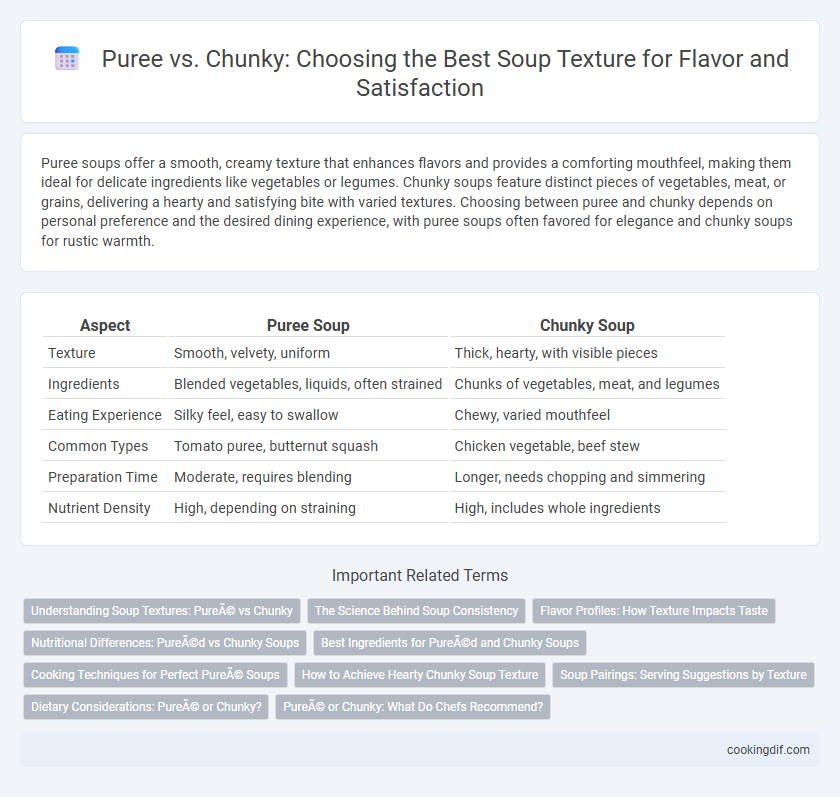Puree soups offer a smooth, creamy texture that enhances flavors and provides a comforting mouthfeel, making them ideal for delicate ingredients like vegetables or legumes. Chunky soups feature distinct pieces of vegetables, meat, or grains, delivering a hearty and satisfying bite with varied textures. Choosing between puree and chunky depends on personal preference and the desired dining experience, with puree soups often favored for elegance and chunky soups for rustic warmth.
Table of Comparison
| Aspect | Puree Soup | Chunky Soup |
|---|---|---|
| Texture | Smooth, velvety, uniform | Thick, hearty, with visible pieces |
| Ingredients | Blended vegetables, liquids, often strained | Chunks of vegetables, meat, and legumes |
| Eating Experience | Silky feel, easy to swallow | Chewy, varied mouthfeel |
| Common Types | Tomato puree, butternut squash | Chicken vegetable, beef stew |
| Preparation Time | Moderate, requires blending | Longer, needs chopping and simmering |
| Nutrient Density | High, depending on straining | High, includes whole ingredients |
Understanding Soup Textures: Pureé vs Chunky
Puree soups offer a smooth, velvety texture achieved by blending ingredients until fully liquefied, enhancing flavors and providing an easy-to-digest option suitable for all palates. Chunky soups present a hearty, textured experience with distinct vegetable, meat, or grain pieces that add richness and mouthfeel, ideal for those seeking a robust and filling meal. Selecting between puree and chunky textures depends on dietary preferences, desired mouthfeel, and the specific soup recipe.
The Science Behind Soup Consistency
The science behind soup consistency reveals that puree soups achieve a smooth texture by breaking down cell walls and releasing pectins, which act as natural thickeners, creating a velvety mouthfeel. Chunky soups retain larger solid pieces, providing varied texture and visual appeal, while maintaining structural integrity that slows down starch gelatinization and protein denaturation. Understanding these processes allows chefs to control viscosity, mouthfeel, and flavor release for optimal soup experience.
Flavor Profiles: How Texture Impacts Taste
Puree soups offer a smooth, creamy texture that enhances the richness and allows subtle flavors like herbs and spices to meld seamlessly, creating a harmonious taste experience. Chunky soups provide varied textures that highlight individual ingredients, intensifying the natural flavors of vegetables, meats, or legumes and adding depth to each spoonful. Texture influences flavor perception by affecting how aromas are released and how taste buds engage, making puree soups feel more cohesive while chunky soups deliver a robust, dynamic flavor profile.
Nutritional Differences: Pureéd vs Chunky Soups
Pureed soups generally offer a smoother texture and can aid in easier digestion and nutrient absorption, especially for individuals with swallowing difficulties. Chunky soups retain more of the original food structure, preserving greater fiber content and providing a more substantial source of vitamins and minerals from intact vegetables and proteins. The choice between pureed and chunky soups influences not only texture but also the bioavailability of nutrients and overall satiety.
Best Ingredients for Pureéd and Chunky Soups
Pureed soups achieve a smooth, velvety texture using ingredients like potatoes, cauliflower, carrots, and butternut squash that break down easily when blended. Chunky soups benefit from heartier vegetables such as celery, carrots, potatoes, and beans, along with tender meats or legumes that retain their shape and provide satisfying bites. Selecting fresh, high-quality produce enhances the flavor and texture whether the soup is pureed or chunky.
Cooking Techniques for Perfect Pureé Soups
Achieving a perfectly smooth puree soup involves simmering vegetables until they are extremely tender, often using techniques like blanching or slow cooking to enhance natural flavors. Using an immersion blender or food processor allows for an ultra-fine texture by gradually blending the soup in small batches. Straining the soup through a fine mesh sieve or chinois ensures a velvety consistency, free from lumps or fibrous bits, ideal for classic puree soups like butternut squash or tomato bisque.
How to Achieve Hearty Chunky Soup Texture
Achieving a hearty chunky soup texture involves using large, uniformly cut vegetables and tender meat pieces that retain their shape during cooking. Simmering ingredients gently in broth allows flavors to meld while preserving individual textures, creating a satisfying bite. Incorporating beans or grains enhances thickness and adds substantial body without resorting to pureeing.
Soup Pairings: Serving Suggestions by Texture
Puree soups, with their smooth and creamy texture, pair exceptionally well with crusty breads, delicate crackers, or light salads that complement the velvety mouthfeel without overwhelming it. Chunky soups offer a heartier experience, ideally matched with robust sides like toasted sandwiches, grain bowls, or rustic rolls that enhance the varied textures and create a satisfying, balanced meal. Selecting sides according to soup texture enhances the dining experience by harmonizing flavors and mouthfeel, whether emphasizing the silky consistency of purees or the substantial bite of chunky soups.
Dietary Considerations: Pureé or Chunky?
Puree soups offer smoother textures ideal for individuals with chewing difficulties or digestive sensitivities, enhancing nutrient absorption by facilitating easier digestion. Chunky soups provide a higher fiber content and more varied textures, promoting satiety and supporting digestive health through whole vegetable and protein pieces. Choosing between puree and chunky soup textures depends on specific dietary needs and digestive comfort requirements.
Pureé or Chunky: What Do Chefs Recommend?
Chefs often recommend puree soups for their smooth, velvety texture that allows for a rich, concentrated flavor experience, enhancing the natural taste of ingredients like roasted vegetables or legumes. Chunky soups are favored when a heartier, more rustic feel is desired, offering varied textures and bite-sized pieces that add complexity and satisfy diverse palates. The choice between puree and chunky textures ultimately depends on the desired dining experience and the specific ingredients used in the recipe.
Pureé vs Chunky for soup texture Infographic

 cookingdif.com
cookingdif.com